Ganesha is above many doors in India, do you know why?
India Delhi #5 History abounds ( Part 2)
Actually, I have to admit today we decided to try the Hop On Hop Off bus… HOHO…..usually great for visitors new to a city to get a feel for, and lie of the land.My friend read out the first review on Trip Advisor… ” this was shit…..” we laughed so much and still did it. result? it is as described ( shit), difficult to find the meeting point, no maps, route different to that on the map ( eventually given to us) and filthy seats. As this is not a review site, I digress.
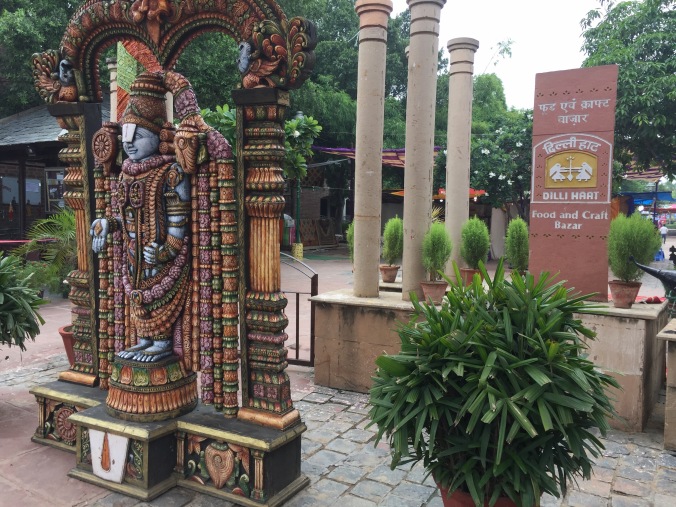
Dilli Haat- nice unhassled shopping and lunch. Good for souvenirs
Previous visits to Delhi have been much more locally oriented, hanging out with locals, eating, walking, looking at all the varied and interre3sting sights around Connaught Place. Check out the book vendors around here, incredible what they have, and so cheap compared to Australia. I pick up books for under $5 AUD each. This trip I was determined to catch the monuments….
TIP: seems to be many hotels ( especially smaller ones) have scant information on most sight seeing activities apart from organised tours. Make a plan, do the research and download travel apps that can be listened to offline whilst going around these monuments…They advertise at the site, but unless you have cheap roaming you are hardly likely to download the app there, check this one out…it seems to have a free trial.Would have been very helpful to us.
Today’s sightseeing sites were:
Dilli Haat– Photo above, we just called in for lunch. Nice group of stores and handicrafts, not too many in your face sales people which is welcomed. The pressure on the streets can be very oppressive.
Qutab Minar
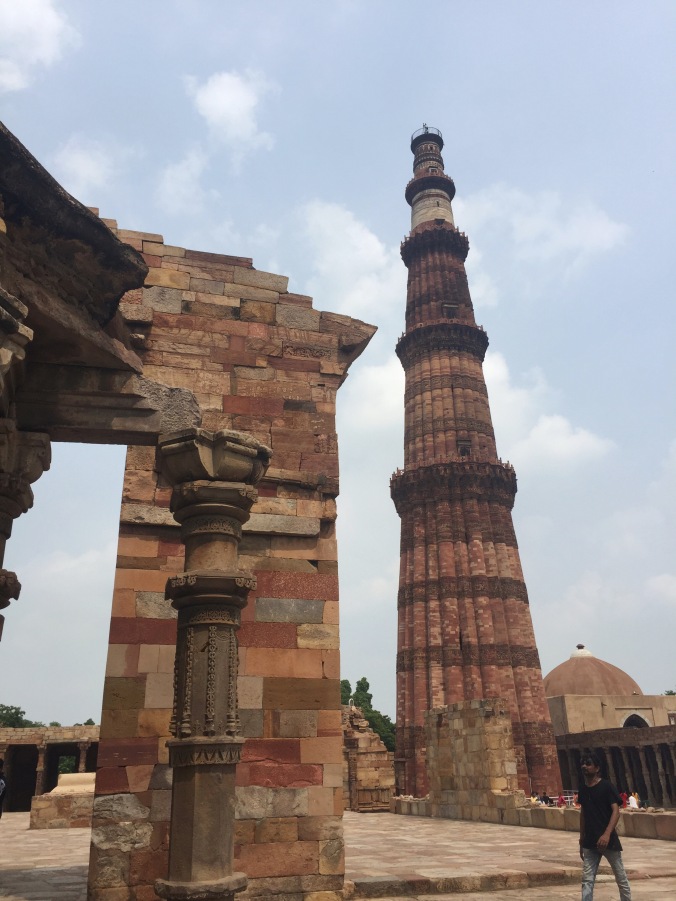
Tower is built in five different stages
Well worth the trip. A 73-metre high tower originally started in approx 1200 AD. Read up here for more info…vey cool in India, you can actually walk around and touch history.
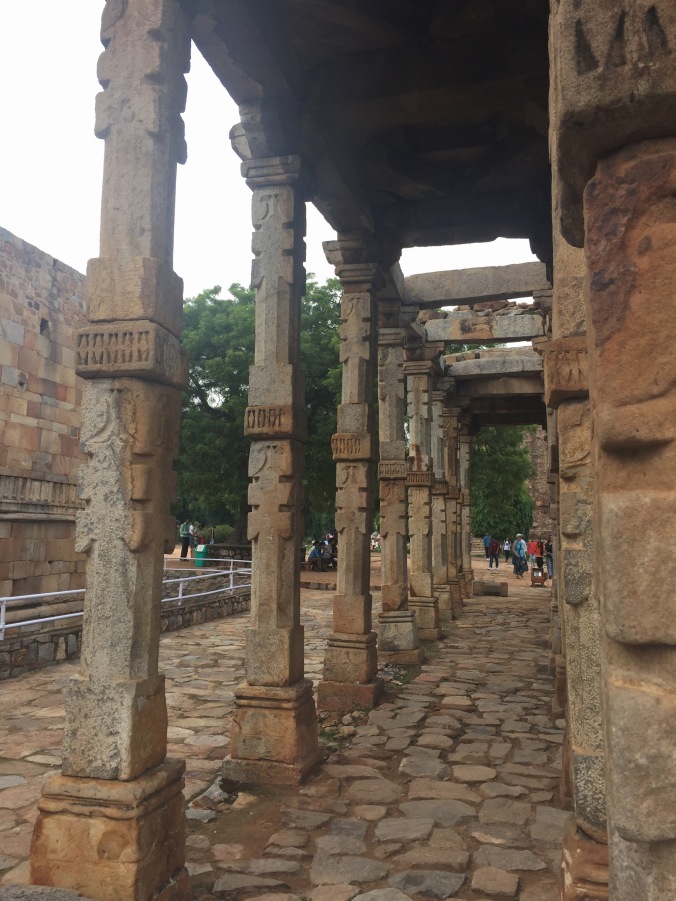
Part of the Qutab Minar complex
The Bahá’í Lotus Temple
In a city dominated by Temples, Mosques, Shrines the Bahá’í built one of the most outstanding pieces of architecture as a place for non-denominational worship. It is like a mini Opera house and is just magnificent, and oh, so quiet.
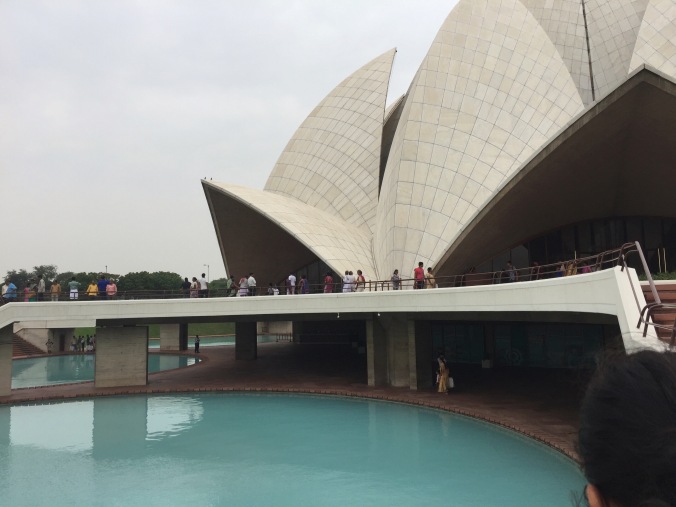
A grey day but look at the water colour!
Humayans Tomb
India has a number of UNESCO heritage sites, and this is one of them. I can’t believe we can actually walk around and be so close to history- in a lot of parts of the world this would be roped off and behind glass ( well parts of it)
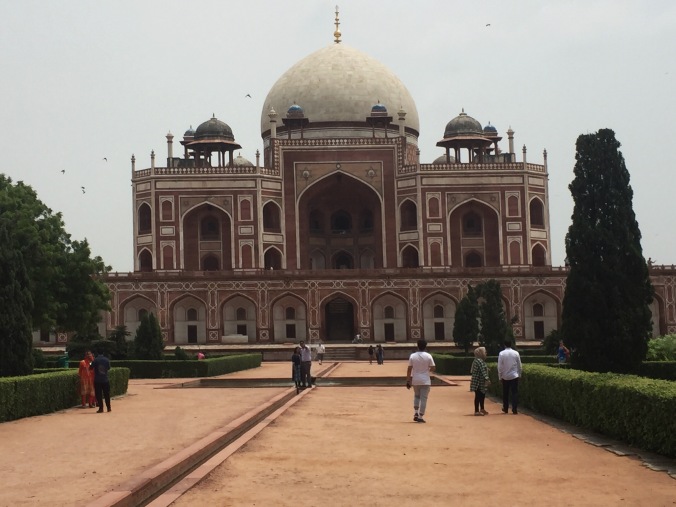
Sometimes referred to as the mini Taj Mahal
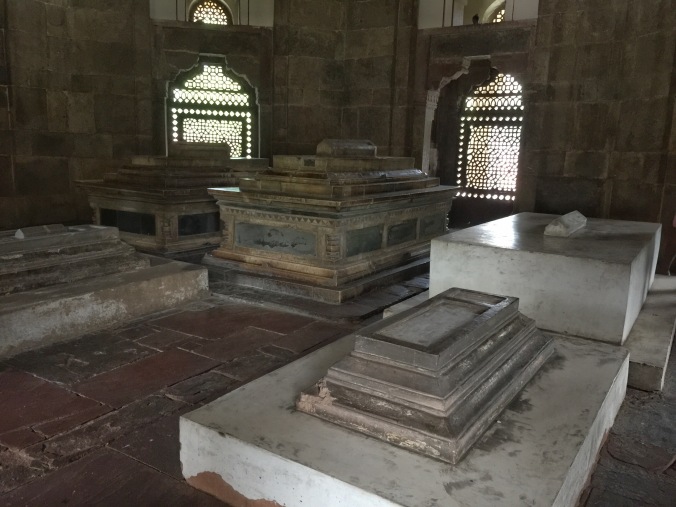
The actual tombs
So that’s it, we are all monumented out now for the day. Time to put our lives at risk again in a crazy auto rickshaw run to our home base near Hauz Khas. Not sure at what point we were ok with going up a three lane highway the wrong way and given the simple explanation of “it’s ok ma’am, it’s legal at night”… really? oh well, must be ok then, after all, this is India…. More to come….
Doors of the world- India
India Delhi #4 History abounds.
Visiting India in monsoon is hot, chaotic and can be trying on the most laid back people at times. Remembering we have a cool hotel room to go back to, whilst most people don’t put it into perspective for me quickly.
Sure, we have heat and humidity in Australia, but this is punishing and relentless for Delhites and the rains are welcome, often romantic. My last post was about the two personalities of the monsoon rains, the romance, and the chaos. This is purely about some of the magnificent historical sites there are to see in Delhi.
The Red Fort, like my last three visits to Versailles, this has been closed on each and every of my six visits to Delhi ( sigh). Rookie mistake….check before you go to any monuments. Closed days for most monuments are Mondays but on this occasion, Independence Day is coming up so security preparations are underway.
First stop is the Sikh place of worship. Gurdwara Bangla Sahib. Located very close to Connaught place it is easily accessible and easy to find.
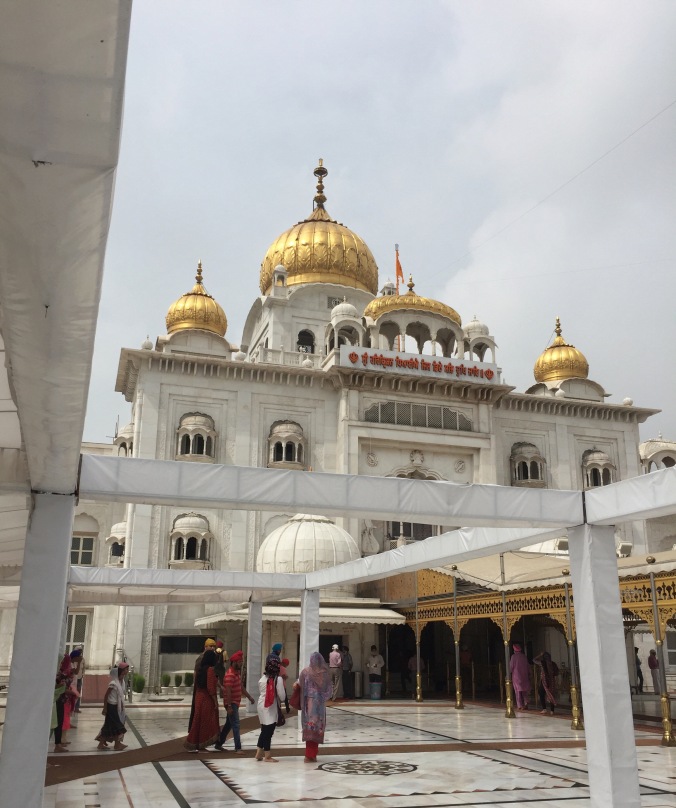
Inside Gurdwara Bangla Sahib
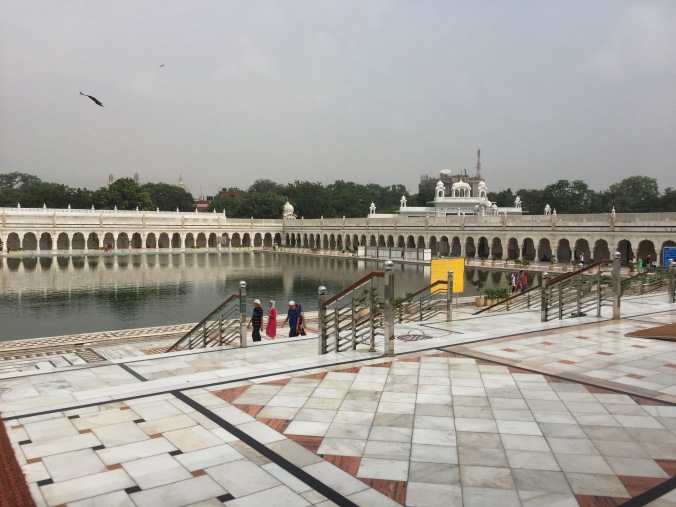
Very serene pool, or Sarovar, even with fish!
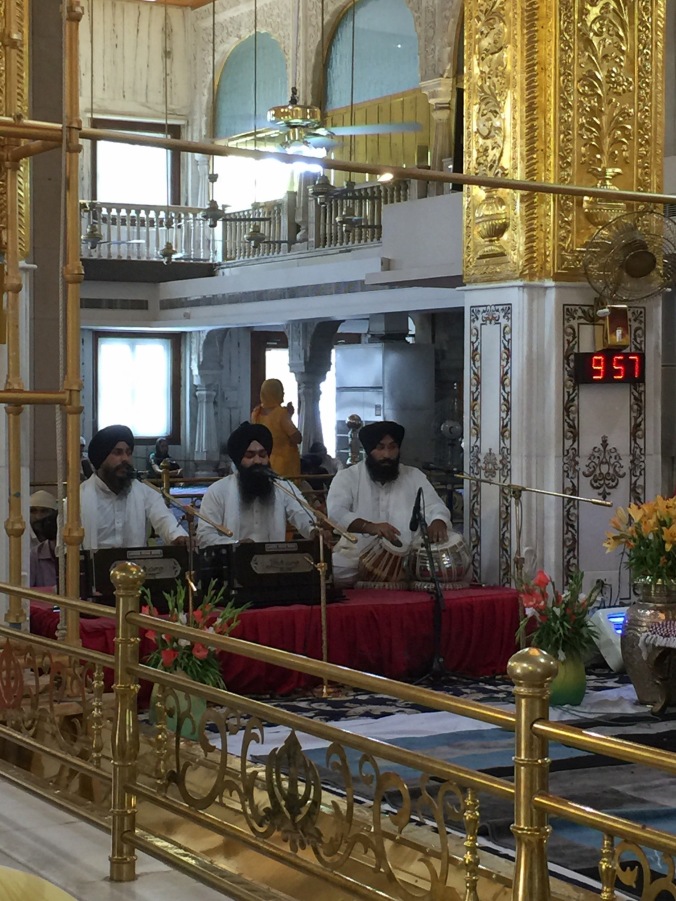
Beautiful hypnotic sounds of kirtan playing inside.
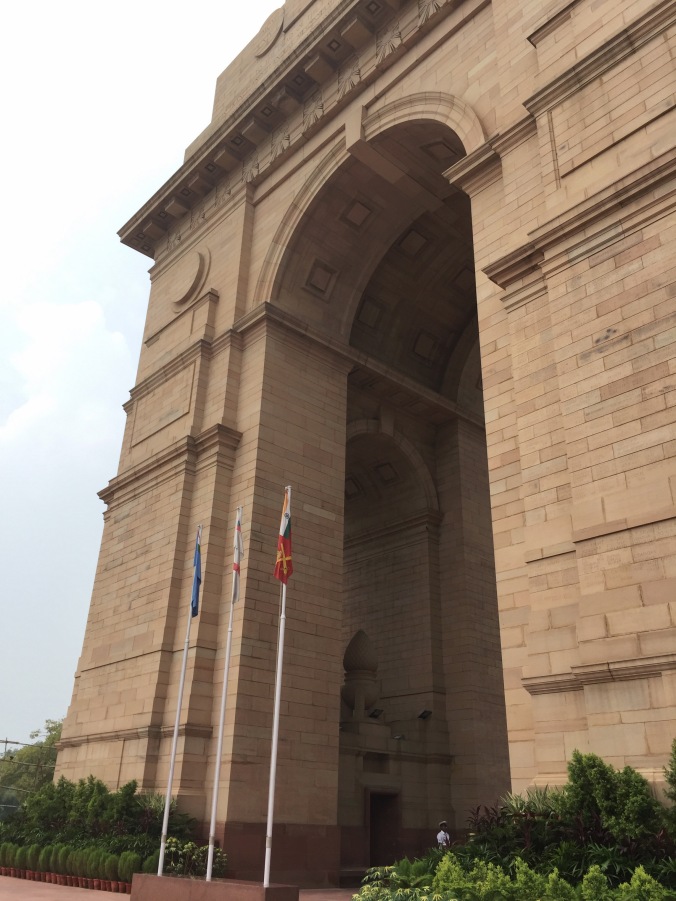
India Gate
It seems apt to now mention Mahatma Gandhi, who, through non-violent civil disobedience was the revered leader who led India to Independence and became an inspiration worldwide. At our bus stop was this guy dressed as Gandi with a Charkha. A good definition is given in this article Needless to say he drew a huge crowd and it was quite moving.
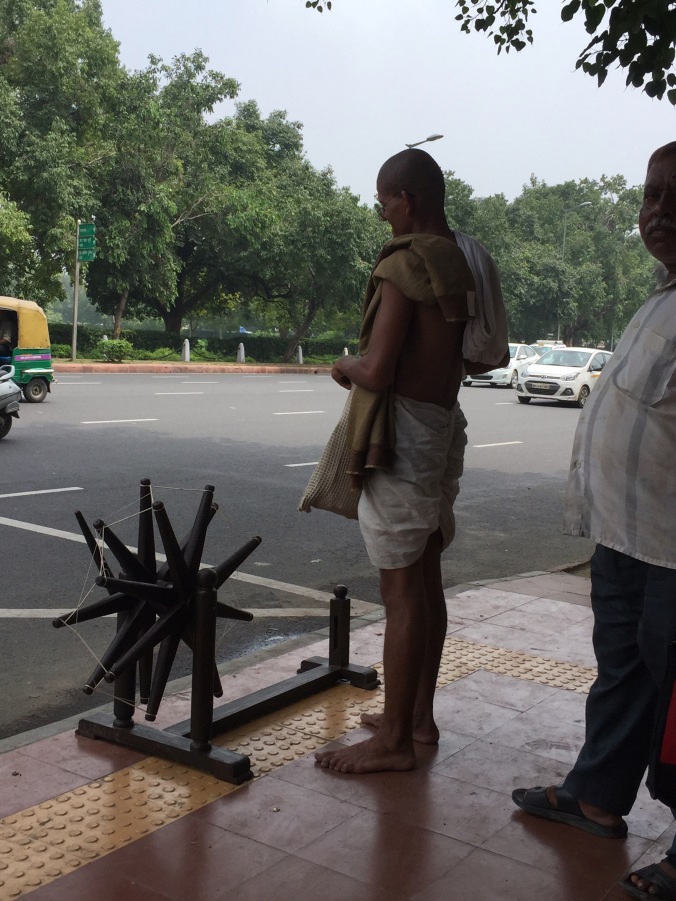
Depiction of Gandhi and his Charkha
By now monument overload sets in, as frankly there is a lot to see and do and would rather take longer at each one than rush around. The heat at this time of year also makes it slow going. Tip: if possible don’t come at this time of year ( August)
India Delhi #3 In search of Baoli
Not being one for organized tours, and this, my sixth visit to India I am feeling pretty confident about finding my way, even learning a basic smattering of Hindi. Helpful? well not really as we found out on a visit to Nizamuddin.
Most monuments and shrines are easy as long as you are respectful and follow the rules, that’s not a big ask. Whilst researching some of the less visited parts of Delhi the stepwells came onto my radar. A stepwell, or Baoli is described by famous French photographer, traveler Louis Rousselet ( 1864) as “[a] vast sheet of water, covered with lotuses in flower, amid which thousands of aquatic birds are sporting” at the shores of which bathers washed, surrounded by jungle greenery. He was not describing a lakeside scene or one of India’s famous riverside ghats, but an ancient well.
So that was the mission for today. Dehli has over 30 stepwells, and I had three on the list to see. This article describes more of the history of these beautiful feats of architecture that make up part of India’s rich history.
A walk through Lodhi Gardens after the rain is peaceful and beautiful amid the relentless traffic of Delhi. Nizzamuddin is where one of the Baoli still intact is a short walk from the gardens. If you intend to go there on your own ( without a guide) be aware this is absolutely not for the faint hearted. Most information I read blithely says, slightly to the north of Nizamuddin Mosque, what is not apparent is that the Baoli is directly at the entrance to one of the most important shrines for the Sufi faith, Hazrat Nizamuddin Darga. Having visited Ajmer Sharif Dargah in
Having visited Ajmer Sharif Dargah in Rajasthan in the company of a family who kept me under their wing the experience was wonderful and enlightening. Not so today. The walk through the market place is confusing and confronting with many places openly slaughtering animals for sale in incredibly unsanitary conditions. The entire marketplace is hot, dirty where it need not be. Poverty is one thing but is that an excuse for the mess and filth this place was? this was another level altogether.
Probably at this stage turning back and revisiting with a guide was a good idea especially for female western tourists. We fell down the rabbit hole and after being pushed and shoved, purchasing flowers and offerings ended up within the shrine where a large sign proclaimed Shariah Law. You need to come here with an open mind, check…an open heart- check…..What we didn’t understand or appreciate, in a place of worship was the pure looks of disgust aimed at us, mostly from women and the need to actually protect ourselves and belongings. We needed to leave now, but no, that was also not going to happen with out the requisite filling out of the “visitors book” and extortion of money. We paid some money just to get out. the prescribed amount seemed to be in the realm of 5,000 rupees. Only carrying small sums of money we simply did not have this and felt very intimidated.
Sufi music is undeniably hypnotic and this shrine has a big night on a Thursday I would love to have gone to, but no way were we stepping back in there. Of course, now I read reviews and see some warnings, in hindsight this was another instance a guide or a small tour would have been a good idea. Self-doubt has crept in somewhat after today…
So did we see the sought after famed step well? YES and it was every bit as amazing as I thought, some eager children happily diving into the pure green water with big smiles on their faces. We left quickly and quietly.
India, Delhi #2 The romance of Monsoon
City of Djinns by William Dalrymple is a travelogue novel I read several years ago about the authors love affair with the city of Delhi. The colourful stories of his time and experiences learning about the history of this intriguing city made for a compelling reason to try and follow in his footsteps.
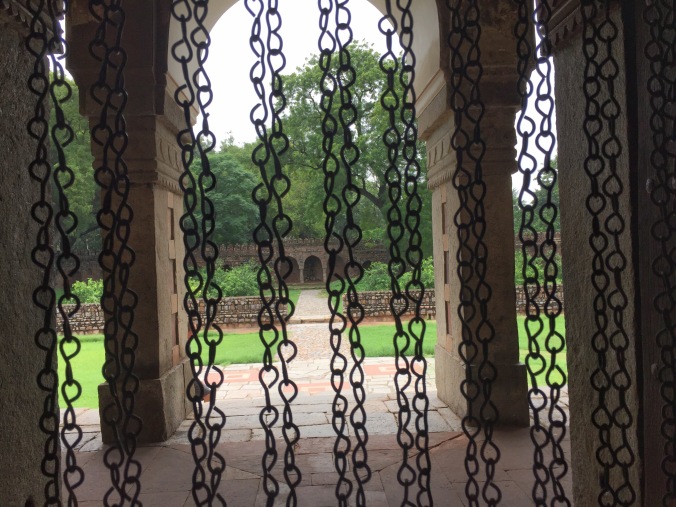
My romantic view of Delhi
Classical poets and music romanticize monsoon. The intense heat, languid afternoons, walks in the gardens and the smell of freshly washed flowers…romance blossoms and is rekindled in the warm rains. A welcome relief from the intense heat at this time of year, it is a time to come out and appreciate nature, the trees have a new sheen to them after being washed, watching children play in the rain..remember when you were a kid? splashing in puddles, standing under drain pipes, dancing in the rain… even on cold days when it rains the noise on my tin roof is comforting and soothing.
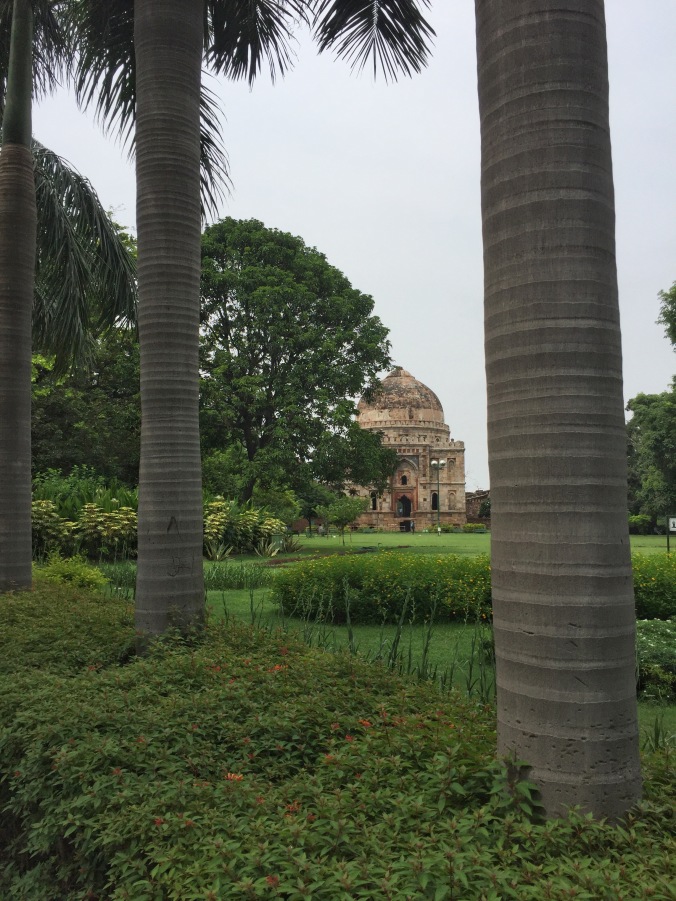
A walk in Lodi gardens after the rain
Six years ago my first visit to India was in the intense heat of summer, what was I thinking? Not realising that pools are generally not common place in hotels here, it was so hot I longed to stay somewhere with a pool. The trip to Rishikesh was long and hot and the relief of a swim was so longed for. Upon arrival, the pool looked so inviting, but as it was getting dark, it could wait until tomorrow. The morning came and to my horror, the pool was being emptied! ” Monsoon is coming madam” of course it would have overflowed…. aghhhh… Monsoon came the promised day and it poured. After initially thinking this was grim I began to enjoy the rain and the joy it brought. I met an extraordinary woman during monsoon, we have remained friends ever since. Maybe we met because of monsoon.
The best part of this monsoon was that I met an extraordinary woman, we talked and talked, and did yoga together for a few days then she flew back to her side of the globe and later I went to mine. We have remained friends ever since. Maybe we met because of monsoon.
Monsoon brings people together, in a sort of “we are all in this together ” frame of mind as witnessed today in Old Delhi. We were aware that monsoon was in full swing, and living in a sub tropical climate we are used to heavy rain. What was an experience it was being in Delhi, a city of 24 million people and an infrastructure that is overloaded. The rains whilst giving much-needed relief from the heat brought the city to its knees. The traffic was gridlocked and the streets flood within minutes. What I didn’t see was tempers overheating ( apart from the obligatory horns that form part of the daily noise in Delhi) or people getting aggressive, but rather, in general accepting and enjoying the rain, getting on with their day and being part of the moment.
A visit to Old Delhi is a must whilst you visit here.There is almost a demarkation line between the old and the new.
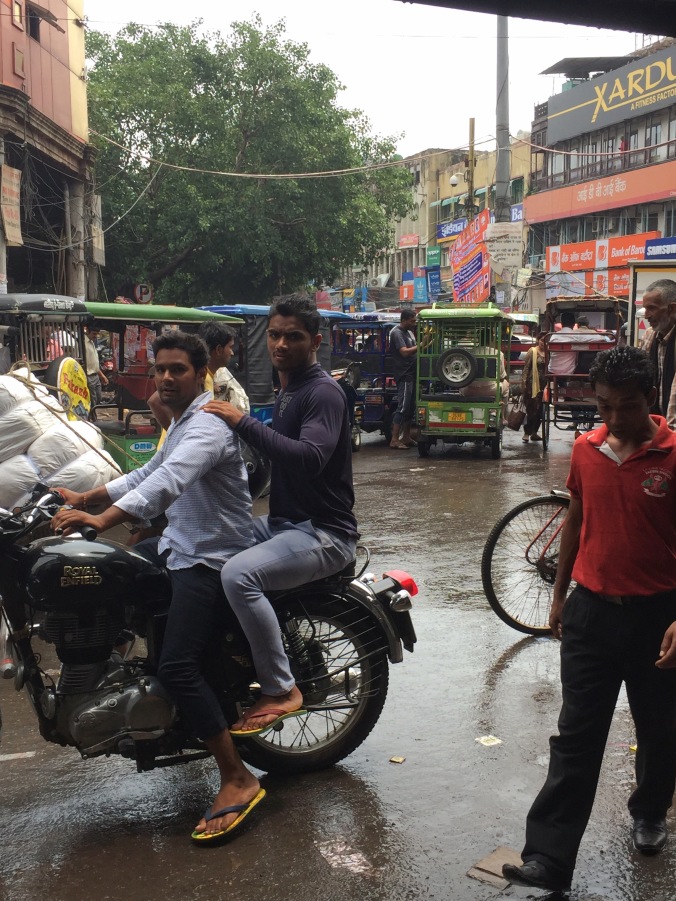
Reality view of monsoon in Old Delhi
Specifically the spice markets of Old Delhi were the destination for today. Once in the Chandni Chowk area everything changes, cycle rickshaws and other auto rickshaws that are only specific to this part of the city ( not allowed into the other areas) abound. This meant getting to know the prices again. Our first trip seemed very cheap at 20 rupee, the driver assuring us his umbrella ( cover on cycle) would keep us dry… after about 50 meters we were soaked so opted to stand in the shelter of a Shiva Temple to wait out the downpour… which only got worse and flooded our comparatively dry spot. Everyone was quiet and happy for the rain but being eager torsits we decided to brave it.
The result was not good and the driver announced the price was actually $20 USD whaaaat? Sure it’s fine to up the price for tourists and haggling over small price hikes for people who earn so little is unfair in my opinion. However this was not on… so beware of this- the US dollar trick was one I hadn’t seen before.
After negoation out of this one we finally found the famed spice markets. A network of streets with all sorts of colourful samples of spices and legumes varying in quality and size. Obviously there is much more going on behind the scenes as men with loads of books and dockets were intensely busy!
Not being one for organized tours this may have been an instance where we would have learnt and understood a lot more had we done this. The streets are chaotic, dirty and probably a place not for the faint hearted. If you are going to pick a walking tour make sure it is one with only a few people as trying to stick with a group honestly would be akin to herding cats!
Spices are a sensory pleasure so spotting a vessel full of something resembling coal was instantly interesting to me . It was indeed Indian black salt, an ingredient I have used but was not aware of its raw form. Also known as kala namak or sanchal. It has a particularly sulphuric smell that is so good in vegan cooking as it makes stuff smell and taste like egg! Its health benefits are numerous according to ayurvedic medicine. Of course this had to be a take home souvenir. Why why why did I decide two kilos of salt was a good idea to haul around in my bag all day. Because it’s what I do, travel and cook….sore shoulders are a small price to pay.
Wrap up of monsoon and old Delhi? both are fabulous and frustrating. Advice after this? Either research very very well, get a private guide ( best idea) or go on a small group tour. (Hindsight is a wonderful thing)
Check out the blogs by Food Tour In Delhi and read some to the great reviews they have… I think well worth it!
India Delhi #1 Friendship day, Lord Krishna.
Being met at the airport with flowers is most girls dream! Today this happened, a friend picked us up bearing flowers for friendship day, what a wonderful start to a trip! The first Sunday of August was declared Friendship Day and made a holiday in the USA in 1935 as a day dedicated to friends and friendship- how did I not know about this!
This is my first trip to India with a friend rather than family or solo and it’s her first trip so it’s very important to me she loves this place as much as I do.August is not necessarily the ideal month to visit as monsoon is still in full swing but tickets were cheap so off we went.
Green Park is a residential neighbourhood of Delhi close to Hauz Khaus, a trendy cosmopolitan area which has numerous cafes and hangouts plus a lovely park. The hotel is, well, ok… it’s clean and comfortable which is all you need when busy out seeing the town, so no recommendations here for this hotel, but the area, yes.
Our first full day was a public holiday in India know as Raksha Bandhan. The day celebrates the love between brothers and sisters. It was one of the quietest days I have ever experienced in India!
ISKCON TEMPLE
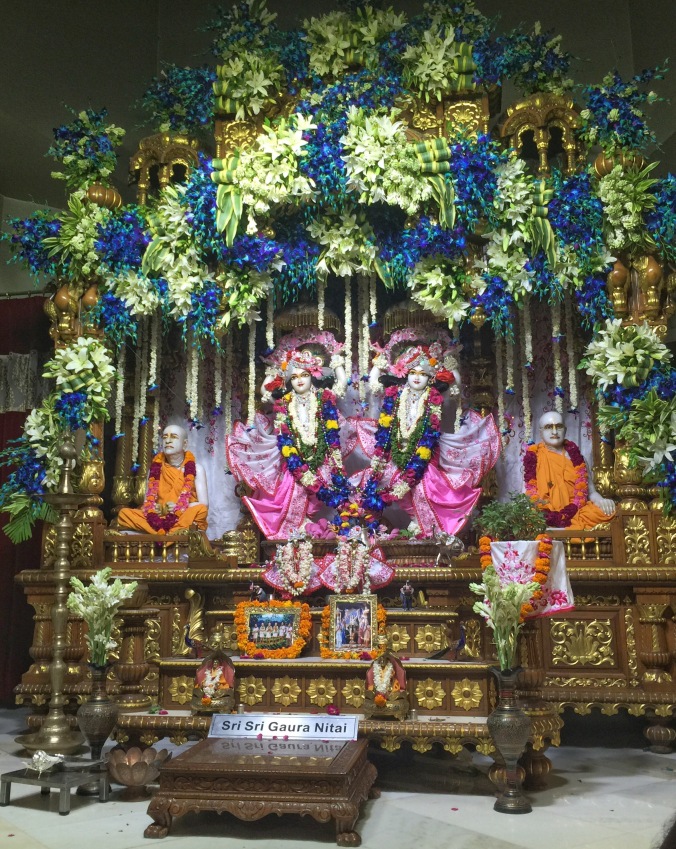
Lords Gaura and Nitai
Located south of the city and near the Baha’i Lotus Temple is the International Society For Krishna Consciousness temple. A truly magnificent and joyous place. Today marked the celebration of Lord Balarama’s appearance day ( birthday) It was colorful, loud and festive. There is a 30 min Vedic show outlining the basics of the Bhagavad Gita which was well done and informative.
On our way out a bird fell from the tree to the ground without a head and its spine protruding out of its body!!! Oh, said the man next to us, must have been a tree snake- good grief !!! I am wondering if this has any significance for me and am trying/hoping to think this is not an ominous sign in any way!!!!
BENGALI MARKET
A trip to Delhi for me is not complete without a visit to this small area. This was where we lost all our clothes once in a fire at the dry cleaners! I was so pleased to see they had rebuilt the business! The sweet shops here are magnificent and a cheap thali lunch is around 280 R for two people ( approx $6 AUD)
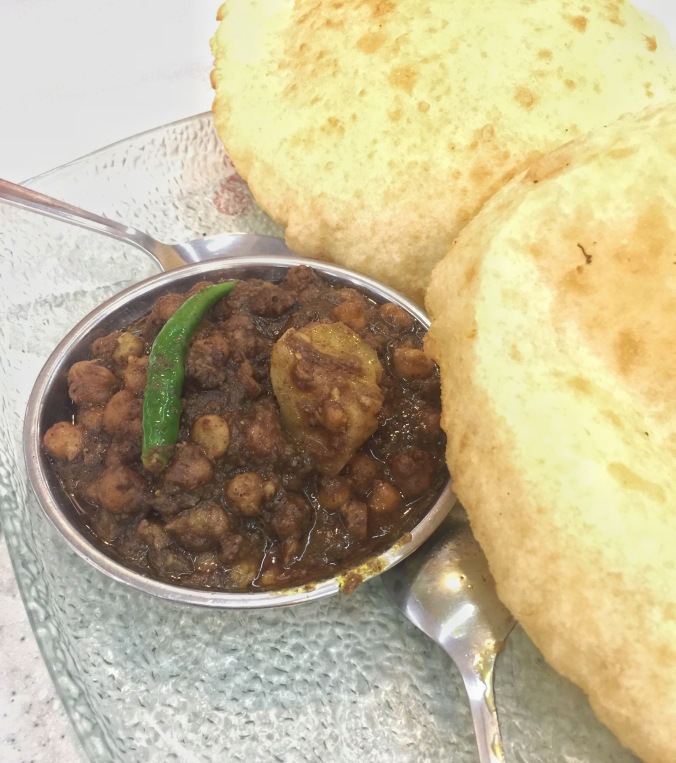
Chole Bhature, a favourite chick pea dish
Then came the rain, and wow did it rain, quite spectacular, although most of what we planned for the day was outdoor so plan B was to head back to the hotel, drenched but happy. The rain initially makes us grim but it soon seeps away and leaves a lush green warmth from the newly washed trees.
After an hour or so of planning it was off the Hauz Khaus, the hip trendy area of Delhi for happy hour and dinner. Again, being a public holiday this vibrant nightlife area was quite quiet tonight so some modern Sufi music at Reloaded, a rooftop bar was just perfect- and the rain had stopped!
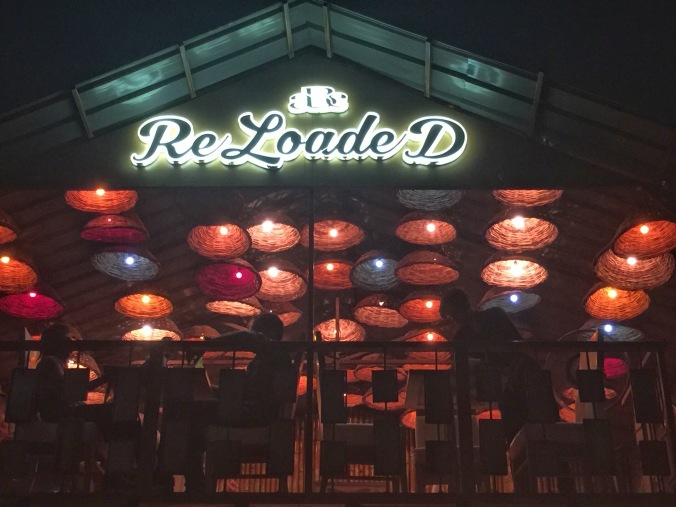
It’s good to be back Delhi, see you tomorrow.
Japanese Fermented Tsukemono made super easy
Learning how to make dishes in different countries is part of my travel experience and life. I was fortunate enough to be tutored briefly by a Japanese chef in Shojin Ryori style cooking and it was there I learned this most basic of all dishes and my jaw dropped as to how easy this was! Seriously there are two ingredients and five minutes of prep that’s it!
Although what I am presenting is super easy I would never underestimate the years of training and skill involved in this style of Zen Buddhist cooking. This is a complete cheats way to achieving a similar result and makes this way of cooking accessible to us.
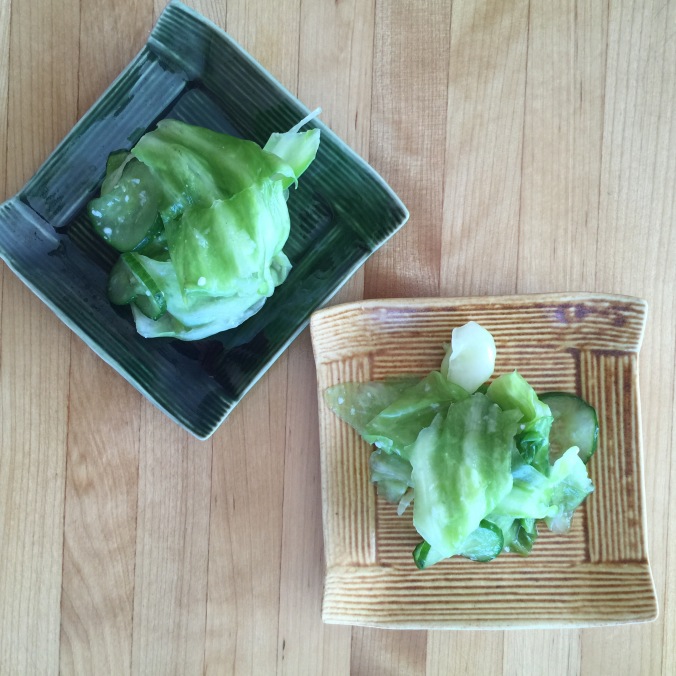
Hakusai No Shiozuke
Hakusai No Shiozuke is Japanese pickled cabbage. I got so excited after making this I have been pickling everything I could employing this method. I posted earlier a recipe for fermented cucumbers on sticks. Also super easy, and a healthy summer snack.
The larger term for pickles is Tsukemono which literally means “fermented vegetables” Fermentation is such a current topic today and it’s all about gut health. Recent visits to Japan have left me wondering how the Japanese are so healthy as there is an incredible amount of processed food in the diet and not too much of an abundance of fresh raw fruit and vegetables due to high costs.
Many countries that do not have an abundance of vegetables often have their version of fermented vegetables such as Kim Chi in Korea, Sauerkraut in parts of Europe and so on.
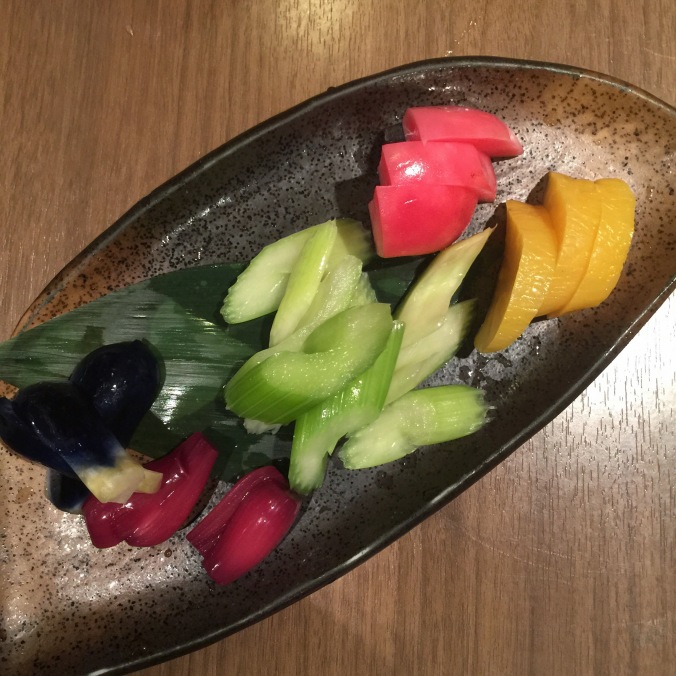
Typical little plate of pickles served before a meal
Koji rice is cooked rice that gets inoculated with a mold which then ferments the rice. At least that’s a very basic explanation. This fermented Koji is used to make other more well-known foods such as miso, sake, soy sauce, and mirin.
Shio Koji can be made, but as this form of fermentation was new to me I think buying the already fermented product is probably much more efficient and safe. The brand I have found easily in Australia is this one When I say easily, look in the Japanese food section of larger Asian stores…
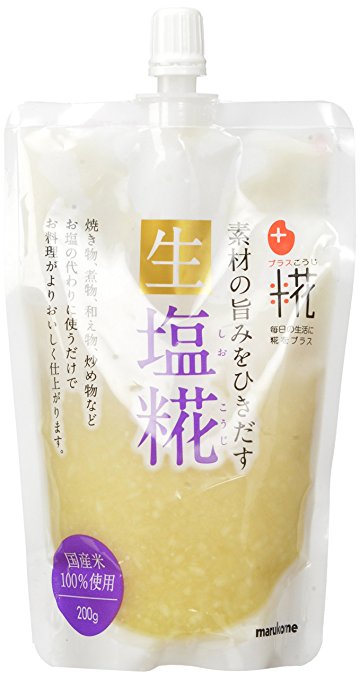
Shio Koji
There are a number of different recipes for Hakusai No Shiozuke available but this one is just the most simple is staggering.
Ingredients
Cabbage ( either wombok or regular)
Japanese Cucumbers ( or Lebanese)
Shio Koji
Ziplock bag
Slice the cabbage finely, about two cups full. Slice the cucumbers diagonally finely or on a mandolin. Put in a ziplock bag with about 1 Tablespoon of the koji rice, massage this well into the cabbage. Let this sit and gently shake from time to time. You will notice the cabbage becoming limper and eventually after about two hours it has turned into a pickle. Seriously that’s it!!!
Add variety like shredded carrots, chilli flakes, what ever you feel like. There you have it, a tasty Japanese Tsukemono. Have fun!
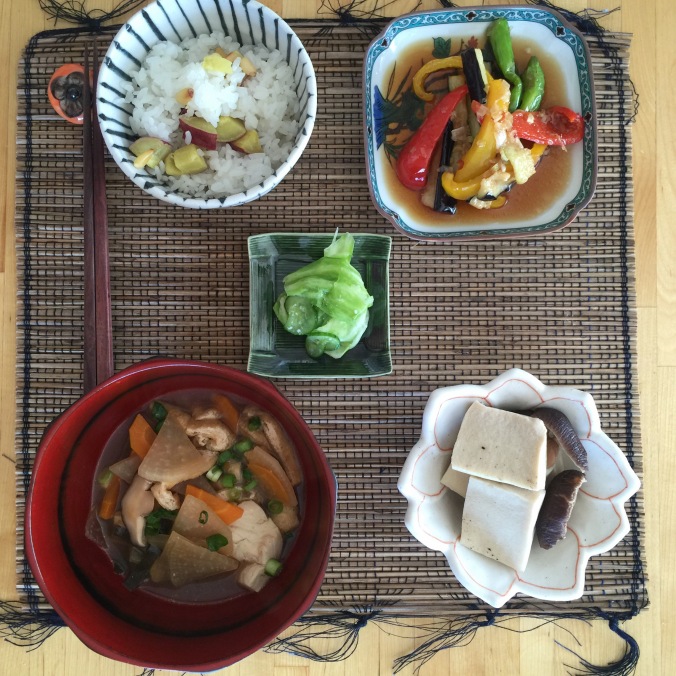
Shojin Ryori lunch with the magic pickle in the centre
Japan- Doors not open to Gaijin
The Japanese are known for their hospitality or Omotenashi. According to Coto Academy, the term defines Japanese hospitality. But its meaning goes way deeper than the way of providing hospitality. The noun means “to entertain guests wholeheartedly”.
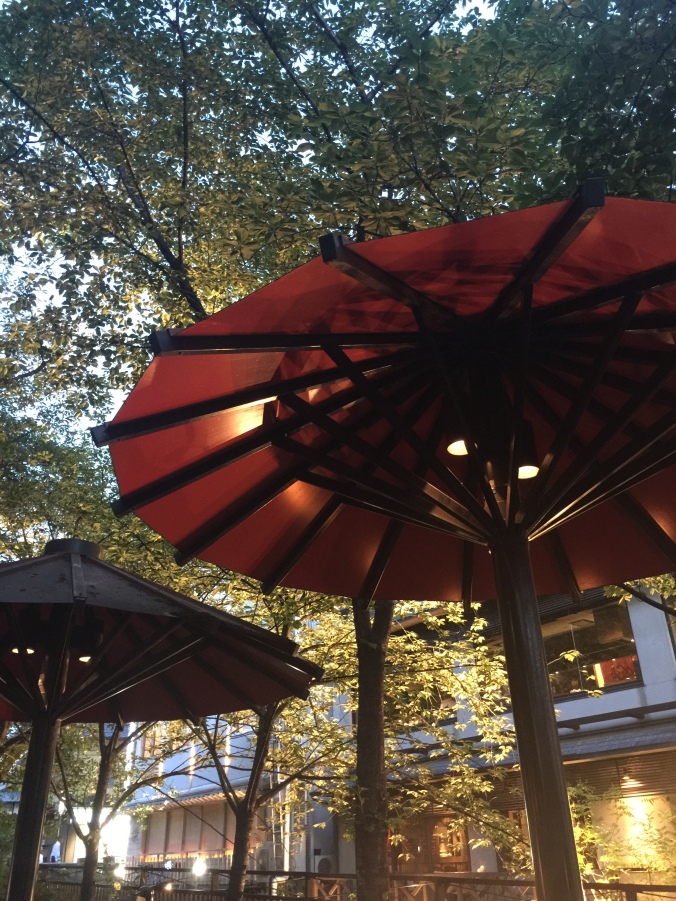
Kyoto at night so pretty, there is another side
Having traveled extensively in Japan, studied both the language, history and culture I was taken aback when flatly refused entry to a piano bar in Kyoto recently. After a day wandering around a city that is easy to love, the idea of relaxing and listening to some cool Jazz music seemed like a great way to end the day. I went to the bar to ask opening times, which I could clearly see on a sign but was told I could not come, of course, I had a puzzled look on my face but this was met with no English spoken from the other party.
This post maybe somewhat contentious, and indeed as a white European woman, I rarely experience racism or cultural alienness. My heart is heavy for those who have to live with this on a daily basis. Over the years of travel in Japan and elsewhere in the world where my physical appearance is different to others, it is understandable that people are curious. This makes me recall a trip to India with my blonde, blue eyed friend who drew a fan club wherever we went, and indeed in the early years of my travel to Japan, my blue eyes seemed to freak people out! fast forward to 2017 and gaijin are not so much of a rare sight in Japan, so this attitude was quite unexpected. This led me to delve a bit further around the streets of Gion. Gion is a neighborhood frequented by the elusive Geisha and the well-heeled people of Kyoto.
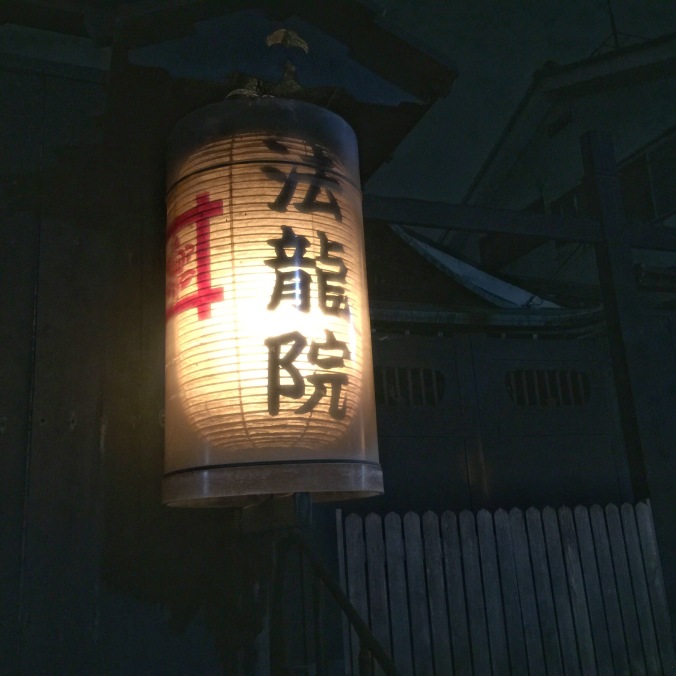
Lots of lanterns
Gion is a neighborhood frequented by the elusive Geisha and the well-heeled people of Kyoto. What I discovered was that there was numerous, very secretive and closed door type of establishments. I initially found this curious until I returned to my hotel and thought it through.
So, had I just been basically told that I was not allowed into the bar because I was Gaijin?
The word for foreigner or non-Japanese is Gaijin. It is slightly derogatory but universally used. An interesting article I read discusses the phenomena that no matter how hard one tries, learns the language or even worse, being born and raised in Japan… if you are non-Japanese, you will never fit in. This article drew a lot of heated commentary admonishing the writer when in my opinion he was pointing out the elephant in the room. I have not had to face this on an on going basis, but this to me seems like racism. Indeed entire thesis has been written on this topic, so I am only scratching the surface here, but comments on this would be eagerly received and discussed.
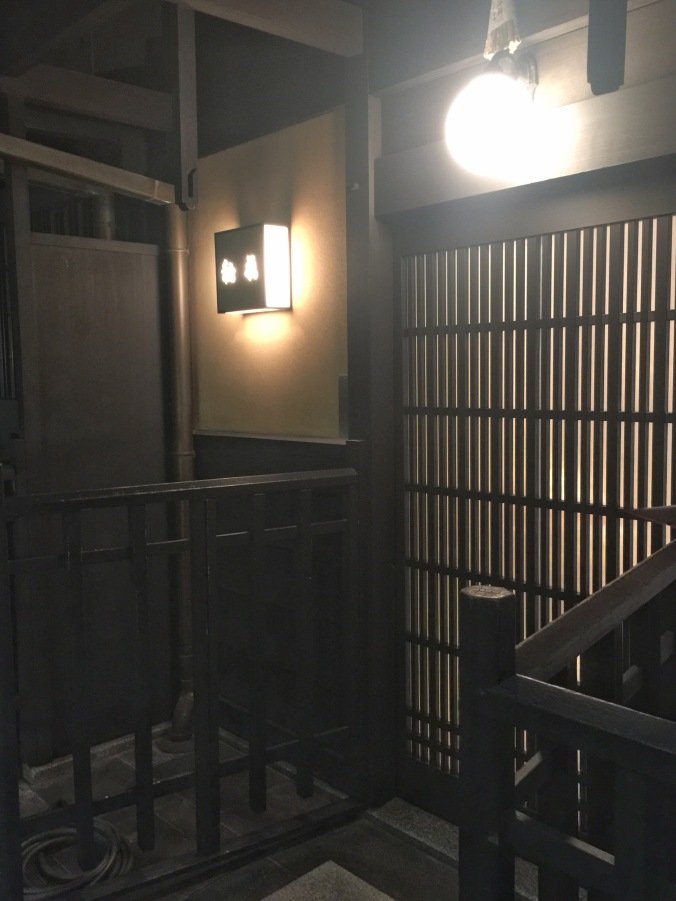
Discreet secluded doorways
I believe I did experience racism. Why should I be surprised? our fellow humans are subject to this on a daily basis all over the world. Maybe it is because we expect too much from the Japanese Omotenashi.
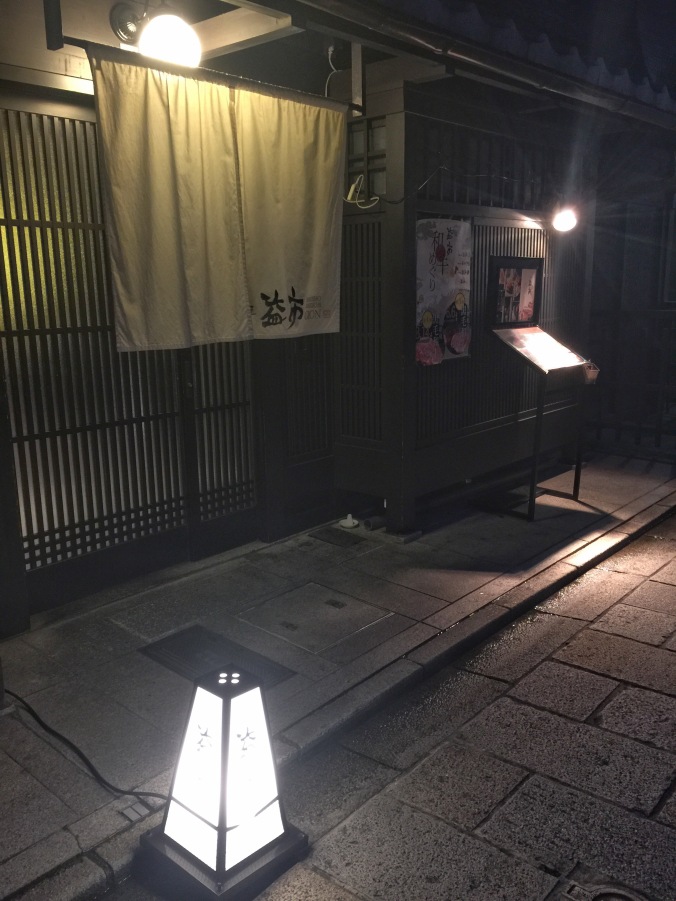
High-end restaurants
Conversely, I am often treated with such cow tailing from people, specifically in India, that it is embarrassing, for want of a better description to feel as though I should be looked up to as a westerner.
Hopefully, and again in a perfect world, one day, as the song goes we will all be One Tribe. ( Black Eyed Peas)
One tribe, one time, one planet, one race
It’s all one blood, don’t care about your face
The color of your eye
Or the tone of your skin
Don’t care where you are
Don’t care where you been
‘Cause where we gonna go
Is where we wanna be
The place where the little language is unity
Osaka: Twisted steel and mechanical crabs co-exist here
The drive from Osaka’s Kansai airport is reminiscent of an apocalyptic movie set. Heavy industrial buildings, seemingly rusty and disused are not what is often associated with the cleanliness and mostly beautiful Japan. Major cities indeed have airports close to industrial areas but this was steel on steroids! The brutal mass of steel and pipes seem never ending, steel and iron works, chemical plants, gas and petrol refining plants, paper plants, and so on….
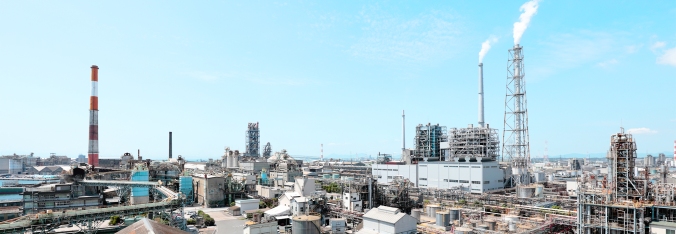
Photo from Ube Industries website
Maybe I am idealistic but geez it’s awful! The airport itself airport is a feat of engineering, built on an artificial island it is certainly impressive and insanely efficient. So this twisted steel nightmare is not the best introduction to Osaka, but don’t be put off. I actually traveled by rail from Kyoto which was a far more genteel way to approach the city. It was on the way out I saw all this and it made me think about it being one of the worst introduction to a city that I have ever seen!
Having set aside two days to explore Osaka seemed reasonable, but to be honest, unless there is something you have your mind on seeing I would rather have spent extra time in Kyoto. I fell in love with Kyoto… you can read my previous posts on the city and see why. So why did it seem that Osaka is a city of confusion? To qualify this, I have had the opportunity to travel to 18 different cities in Japan and found Osaka did not seem to have a distinct uniqueness, please comment on this if you have a different opinion and let me know where to go on a return visit. Of course, my opinion is totally subjective only based on a brief visit.
The major tourist attraction is Osaka Castle which is indeed an impressive sight and added more insight into my fascination with the Shogun era. After that, it seemed to me that the city lacked a bit of soul, or was maybe confused as to its identity. Osaka is a large city with a great canal through the middle, historic alleys, sites, and massive loud neon signs all seeming to co exist here.
Inside Osaka is a wonderful guide by the same guys who wrote Inside Kyoto. Both guides are highly recommended by the way! their suggestions and itineraries are awesome without being too rushed, especially if you are time poor.
WHERE DID I STAY
Airbnb has been fantastic for the last two destinations of Tokyo and Kyoto. The only issue is the check in/out times. Check out was 10 am in Kyoto and most check-ins aren’t until 3 pm… which would have left me wandering around with a case ( I’m not keen on leaving in train stations) so a hotel seemed like a good choice. Close to the main train station which is in Kita Ward (section) is an area called Umeda, or Kita- Umeda. It’s really central, close to shops and transportation. I had never really stayed in a salaryman hotel before so this was going to be interesting. Hotel Hokke Club was fantastic, and a full buffet breakfast ( Japanese) was included. They have a public hot bath ( separate men’s and ladies) and a stand full of nice goodies such as bath crystals and face masks in the lobby which was a nice extra. This was my first experience in a public bath and it was fun! My very first post was written to include this. It was inexpensive ( around $70 AUD) and very comfortable. Check in was not until 2 pm but at least I could leave my bags safely whilst I set out exploring.
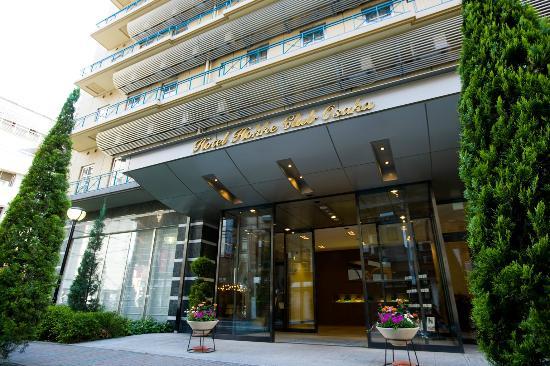
DAY ONE
NAKAZAKICHO
Before arriving in a city, a google search for “hipster ” areas of the place I am to visit yields spots that are new, groovy and upcoming often with plenty of street art, musicians, alternative food and arty characters. Tokyo has Harajuku- which really is a tourist trap, fun and quirky but no longer totally original. Osaka’s curent hip spot is Nakazakicho. This was a short walk from the hotel and it didn’t disappoint. The area is a labyrinth of small back streets and alleys which deserve to be discovered in no particular order but rather wander, stop, look and soak in all the retro cafes, scenes, and stores.
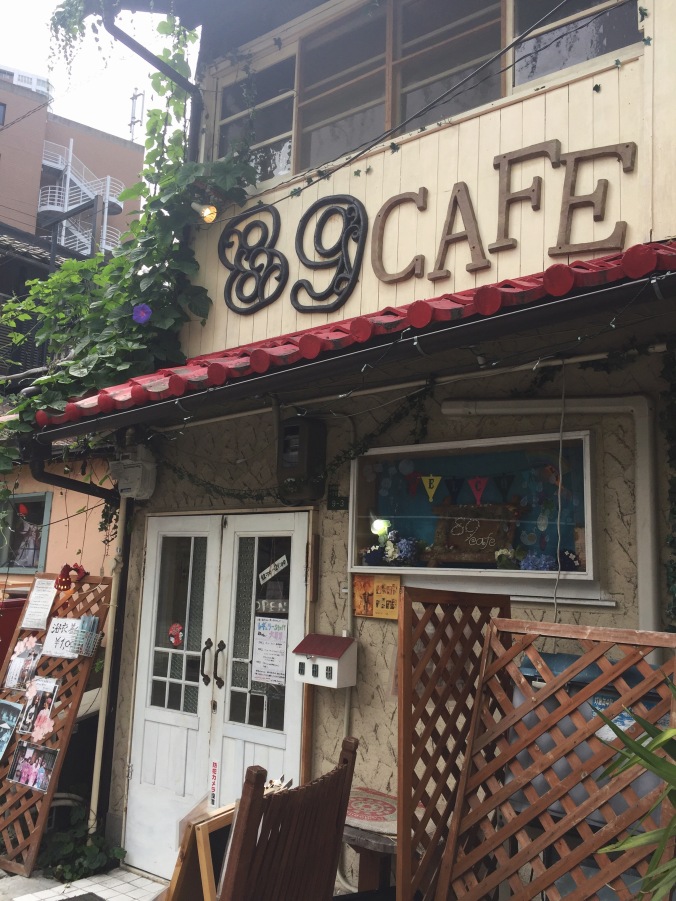
Retro and quirky cafes
The houses date back to the Showa Era of the 1920’s, surviving the air raids of WWII. Renovation started here only a few years ago, and to date, there are no big name bands anywhere near this area. Let’s hope this unique area stays like it is. Inside Osakas guide was an interesting read, although some places I would like to have visited didn’t seem to still be there.
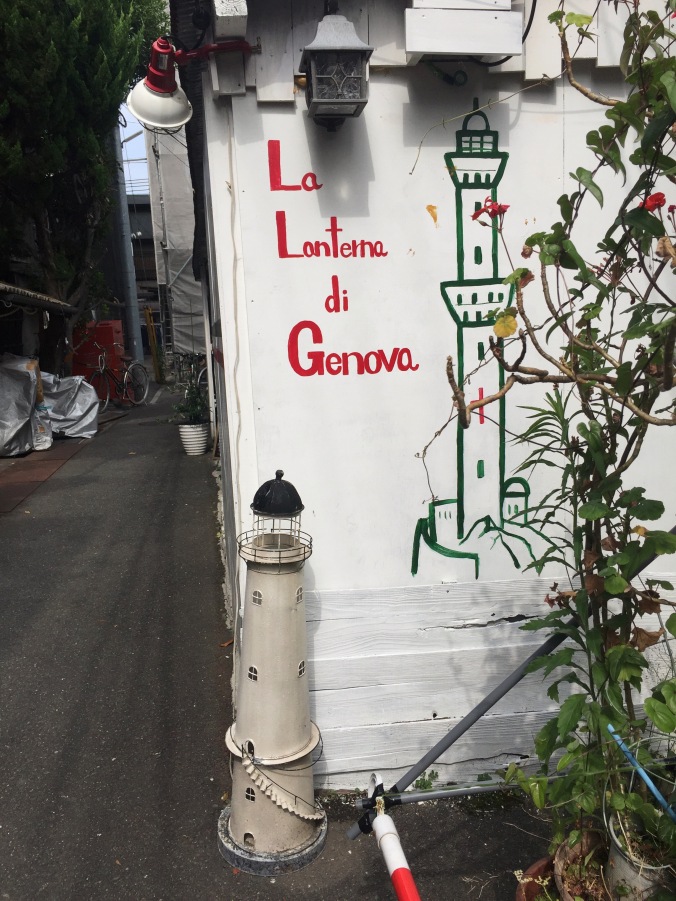
Street art abounded and was clever and calm, unlike some of the more aggressive tags we see adorning city walls. A feature of many places was an abundance of items dating from the 1950- 1960s which may well have been introduced to Japan during the years of occupation directly after WWII.
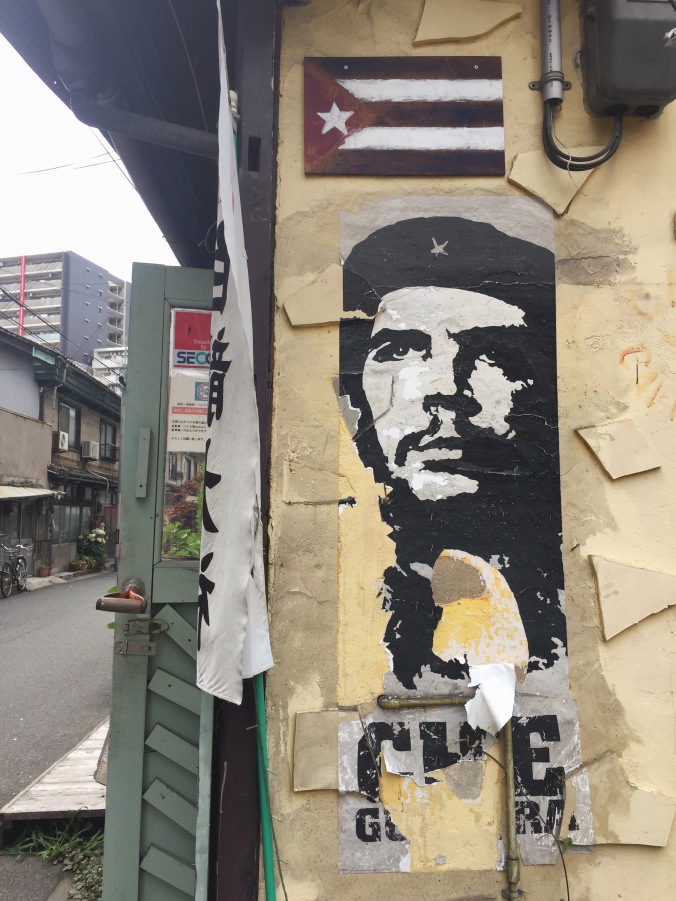
I wonde what Che Guevara thinks of this place?
DAY TWO
OSAKA CASTLE AND MINAMI AREA
The walk approaching Osaka castle ( Osaka -jo) is just lovely and the surrounding park (Osaka Castle Park) is quiet and expansive. Osaka castle is an imposing and magnificent building which can be seen from many areas of the city.
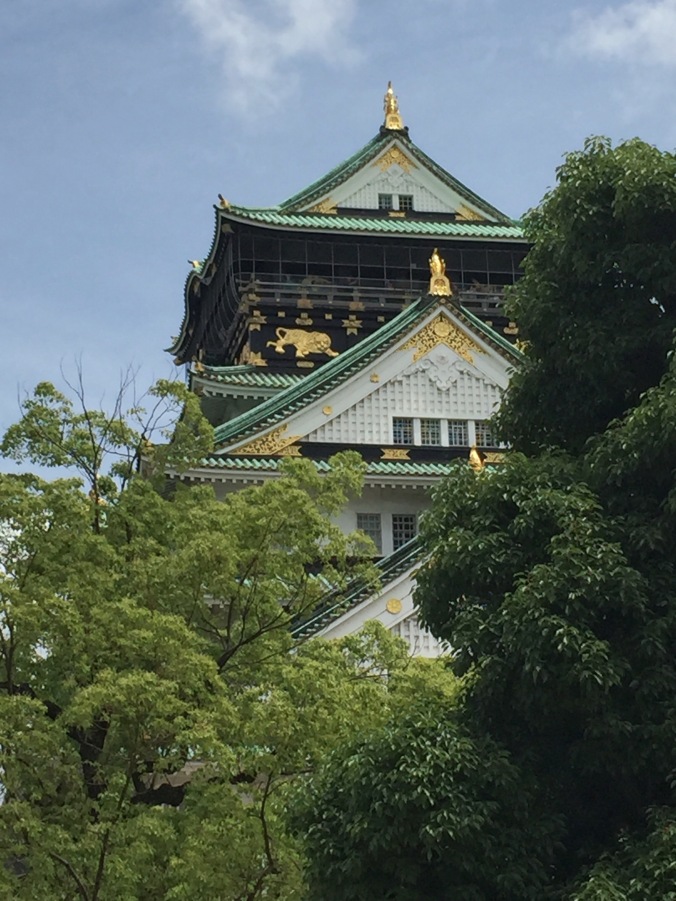
The Castle has an authentic looking exterior but is a modern concrete building inside. There is even a lift to make access easier to the several floors of museum detailing the history. Originally built in 1583 by Toyotomi Hideyoshi it has been burnt down three times and most recently re built starting in 1931 and completed in 1955. My fascination with the first Shogun Tokugawa Ieyasu meant that a visit to Osaka Castle was a must for me. The Tokugawa shogunate started in 1600 and in 1615 Ieyasu laid siege to Osaka Castle and wiped out the Toyotomi clan, whom he had seen as the last remaining threat to Tokugawa rule. Osaka Castle is an important historically significant site which bore witness to the period that began the unification of Japan.
Entrance to the castle is inexpensive, and if you have time there is also a boat cruise around the moat which looked like good value bought as a combo ticket, on this occasion the castle visit was all I did. The elevator takes you close to the top floor. You will need to walk up two flights only to soak in the full view from this eagles nest vantage point. Then each floor on the way down relives the history of the families and battles over the years. I soaked all of this up and came out feeling like another piece of my Shogun historical puzzle was in place.
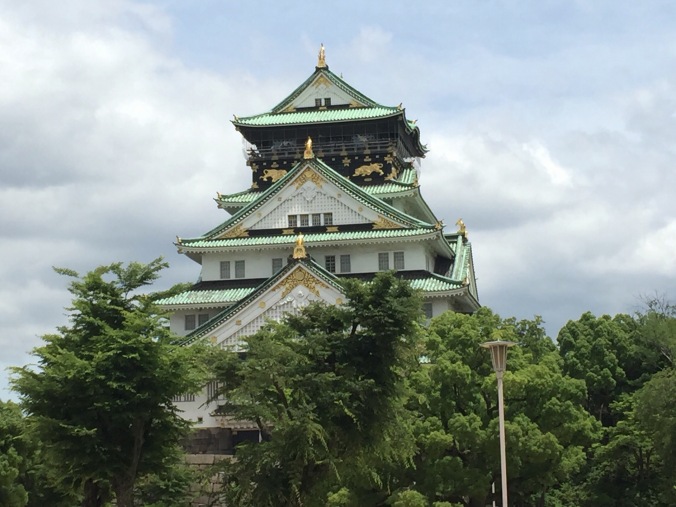
From the castle, I walked to Minami area which was good exercise and an easy walk. It was a warm sunny day and the city is good for walking. In this area the main sights are:
Dotomburi – a loud bustling entertainment street with huge restaurants and touts outside, all screaming for business. There was a mechanical crab on one huge restaurant and on another, an octopus beckoning patrons inward. As I am vege these held no appeal but were entetaining. Rather I got out Happy Cow and found a very cute vegan organic cafe. Its somewhat frustrating being in Japan and wanting to try plant based food, however most of the places I have come acoss seem to all do western style food such as hummus and bagels. Lunch was lovely but not the Japanese food I was craving for.
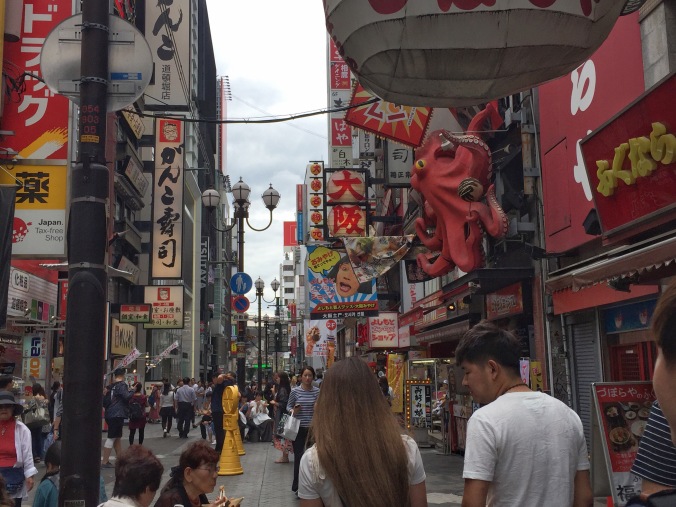
The tentaclesbecon diners in!
Shinsaibashi- suji
Osaka has two main shopping, or urban areas: Kita/Umeda and Minami. The place to head in Minami is Shinsaibashi- suji Arcade- a fully covered arcade which runs parallel to Midosuji- a wide tree lined avenue and home to all the big names such as Chanel, Gucci and the like.
Hozenji Yokocho
Of most interest to me ( as I wasn’t shopping) was Hozenji Yokocho. After being spoilt with all the atmosphere that was Kyoto, Osaka had, to date seemed somewhat rough and ready, until I found this small area consisting of two cobbled streets housing more traditional shops and restaurants. The area is named after the Buddhist temple of Hozenji – ji. This is which is where you will find the moss covered Buddhist statue called Mizu- Fudo ( mizu means water) . The entire area was razed by fire durring WWII but this deity remained intact. The ritual is to splash water onto the statue, hence it is covered in moss.
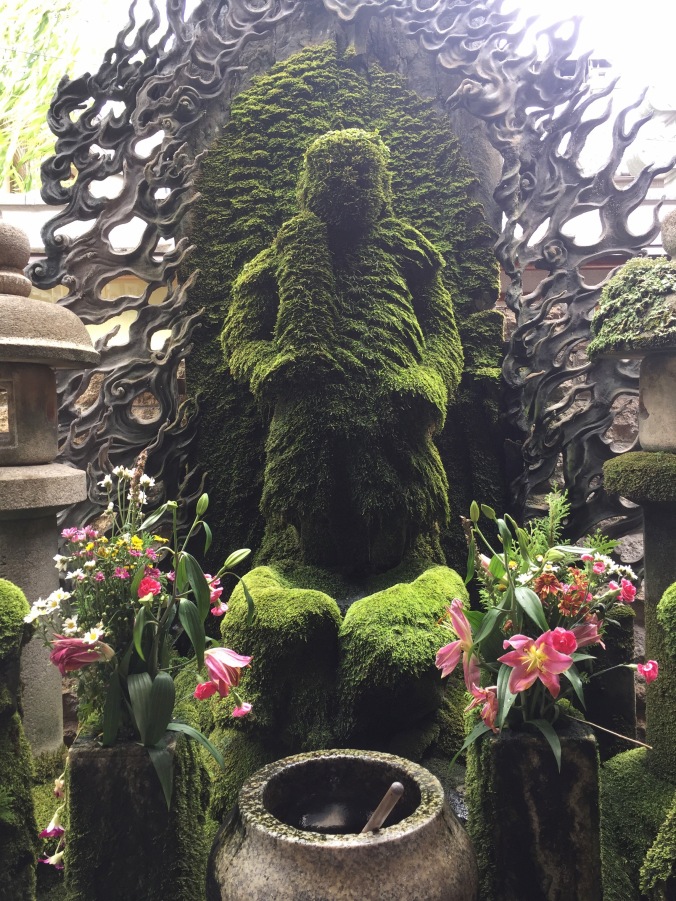
Mizu- Fudo
There is a tiny alley of small shop fronts recreating scenes reminiscent of the Edo era. I couldn’t find much information about this, so it was a nice little find, connecting this quaint area to the madness of Dotomburi.
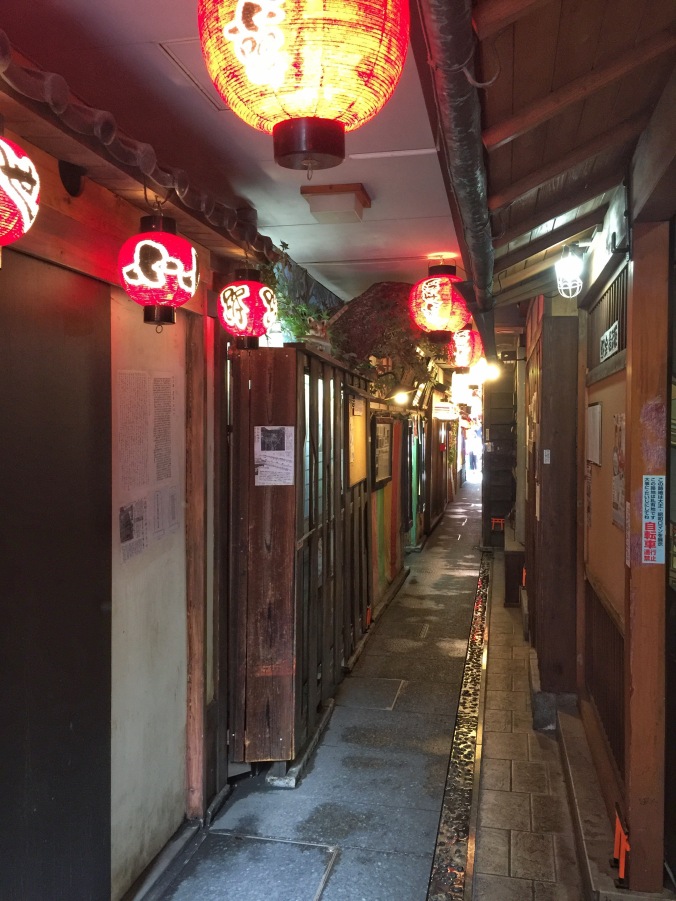
You have to search to find this alley, it’s near the statue of Mizu Fudo and connects to Dotomburi
This trip to Japan has now sadly come to an end. I traveled mostly solo which has advantages and disadvantages. In any country where communication may be somewhat difficult, our reliance on information often comes from what you can read up on and research whenever wifi is available. Or view it as an adventure into the unknown, often the best experiences may be those we do not anticipate.
My next travel is to Malaysia, and Kuala Lumpur, a city I love. Thanks for reading.









